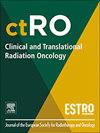磁共振成像检测脑部恶性疾病中的肿瘤缺氧:验证研究的系统回顾
IF 2.7
3区 医学
Q3 ONCOLOGY
引用次数: 0
摘要
肿瘤缺氧提示脑恶性肿瘤预后较差;然而,目前评估肿瘤缺氧的金标准方法是侵入性的,通常难以获得。磁共振成像(MRI)已广泛应用,但其在识别肿瘤缺氧或缺氧相关新生血管生成方面的有效性尚未得到很好的表征。在PubMed和Embase数据库中进行了系统的文献检索。搜索查询确定了MRI研究,验证了缺氧替代成像序列对脑恶性肿瘤患者的金标准缺氧或新血管生成检测方法的有效性。文献筛选发现了2007年至2022年间出版的23份手稿。在常规MRI序列中,对比剂给药后肿瘤周围水肿和信号改变与金标准氧评估方法相关。T2*-和T2 '衍生的测量方法与金标准方法相关,而氧萃取分数的定量测量报告相互矛盾。纤维密度、组织细胞度、血容量、血管传递时间和渗透性测量与金标准方法相关,而血流量测量结果相互矛盾。MRI测量是肿瘤缺氧或缺氧相关新血管生成的有希望的替代品。需要更多的研究来调和不同的发现。未来的敏感性分析需要建立最准确地识别肿瘤缺氧的MRI方法。本文章由计算机程序翻译,如有差异,请以英文原文为准。
Magnetic resonance imaging to detect tumor hypoxia in brain malignant disease: A systematic review of validation studies
Tumor hypoxia indicates a worse prognosis in brain malignancies; however, current gold-standard methods for assessing tumor hypoxia are invasive and often inaccessible. Magnetic Resonance Imaging (MRI) is widely available, but its validity for identifying tumor hypoxia or hypoxia-related neoangiogenesis is not well characterized. A systematic literature search was performed across PubMed and Embase Databases. The search query identified MRI studies that validated hypoxia-surrogate imaging sequences against gold-standard hypoxia or neoangiogenesis detection methods in patients with brain malignancies. Literature screen identified 23 manuscripts published between 2007 and 2022. Among conventional MRI sequences, peritumoral edema and signal change after contrast administration were associated with gold-standard oxygen-assessment methods. T2*- and T2′-derived measures were associated with gold-standard methods, while reports on quantitative measures of oxygen extraction fraction were conflicting. Fiber density, tissue cellularity, blood volume, vascular transit time, and permeability measurements were associated with gold-standard methods, whereas blood flow measurements yielded conflicting results. MRI measures are promising surrogates for tumor hypoxia or hypoxia-related neoangiogenesis. Additional studies are needed to reconcile disparate findings. Future sensitivity analyses are needed to establish the MRI methods most accurate at identifying tumor hypoxia.
求助全文
通过发布文献求助,成功后即可免费获取论文全文。
去求助
来源期刊

Clinical and Translational Radiation Oncology
Medicine-Radiology, Nuclear Medicine and Imaging
CiteScore
5.30
自引率
3.20%
发文量
114
审稿时长
40 days
 求助内容:
求助内容: 应助结果提醒方式:
应助结果提醒方式:


